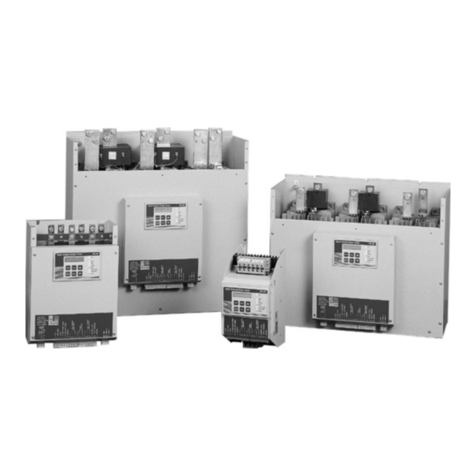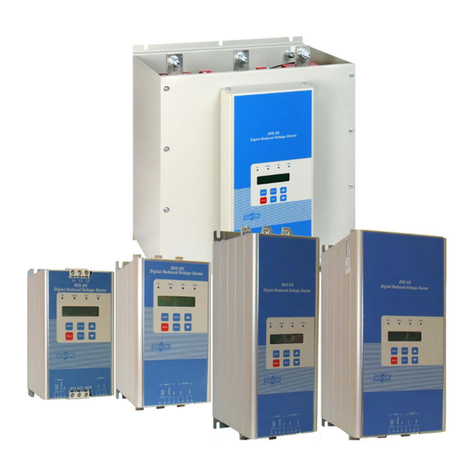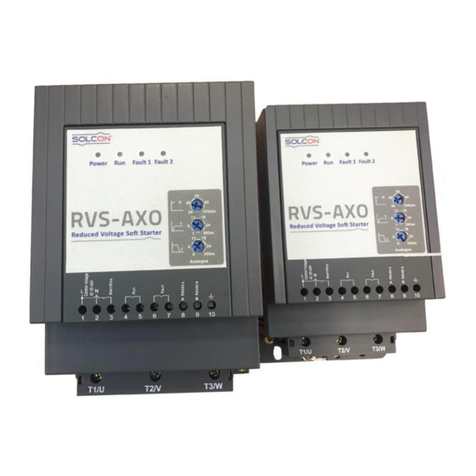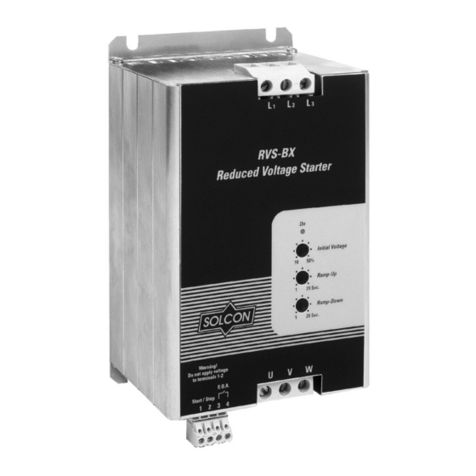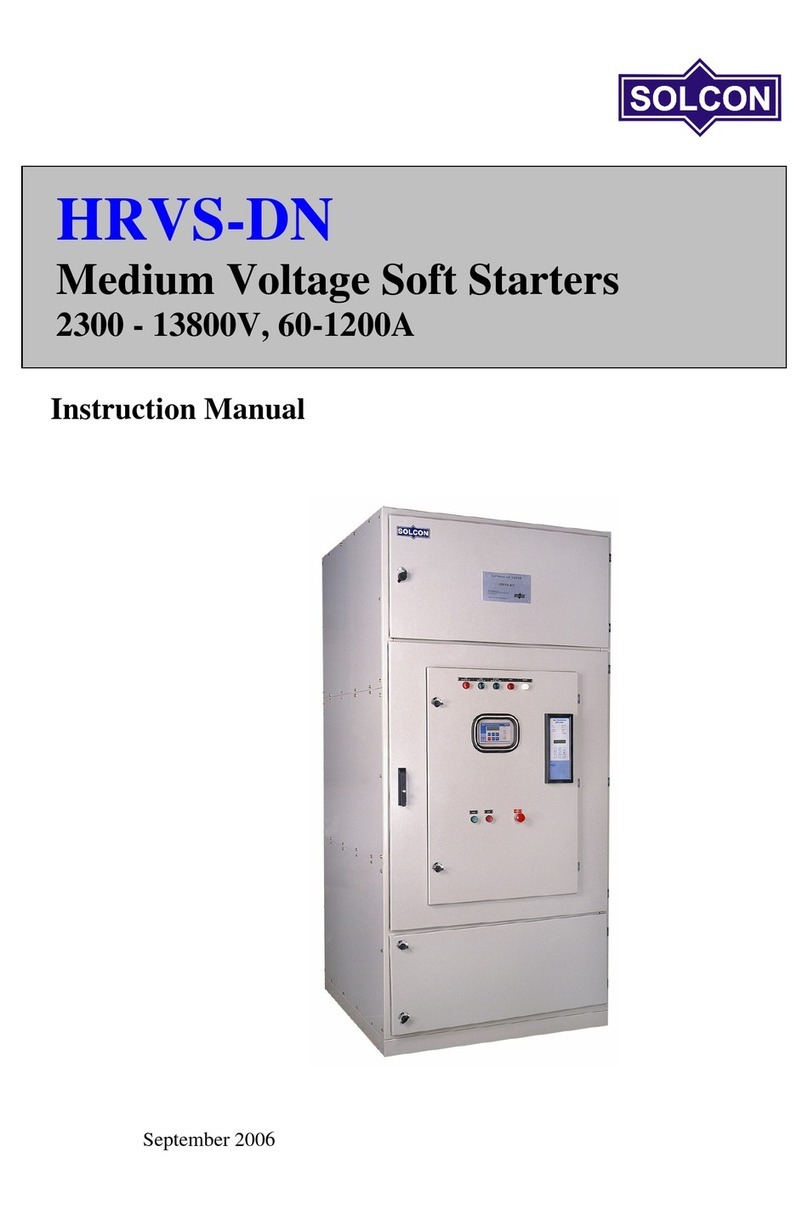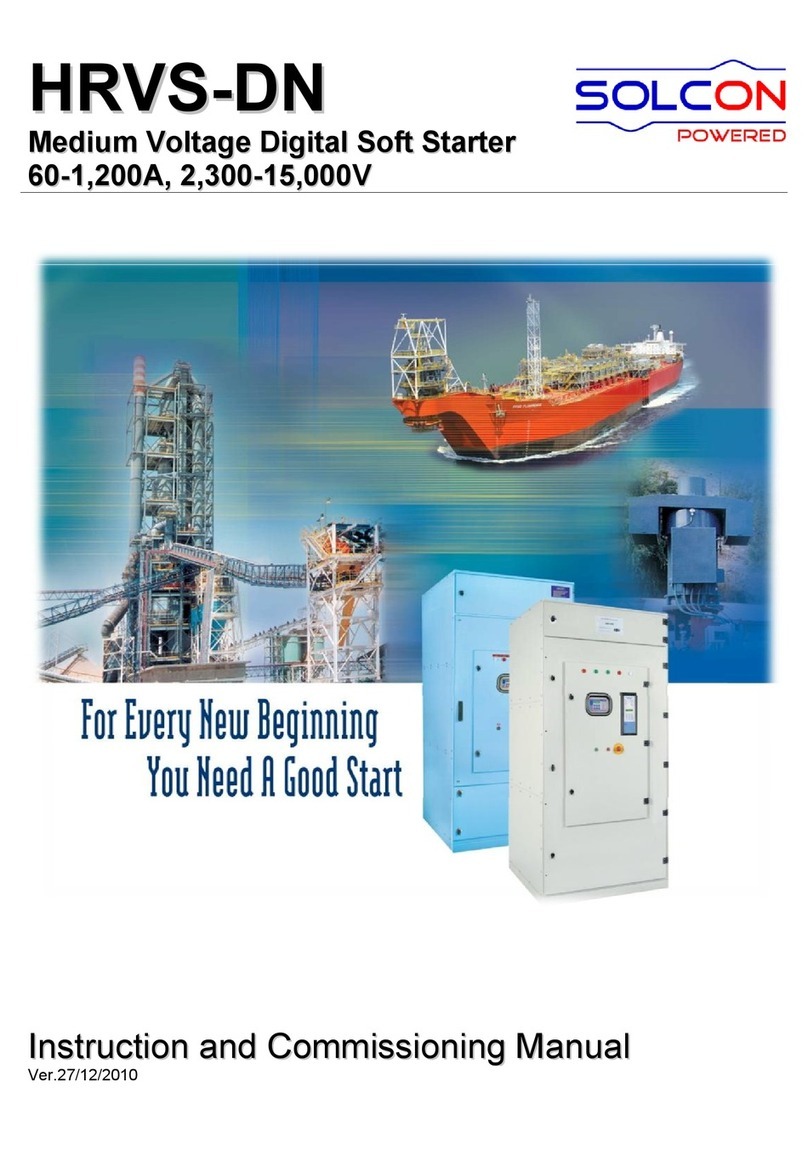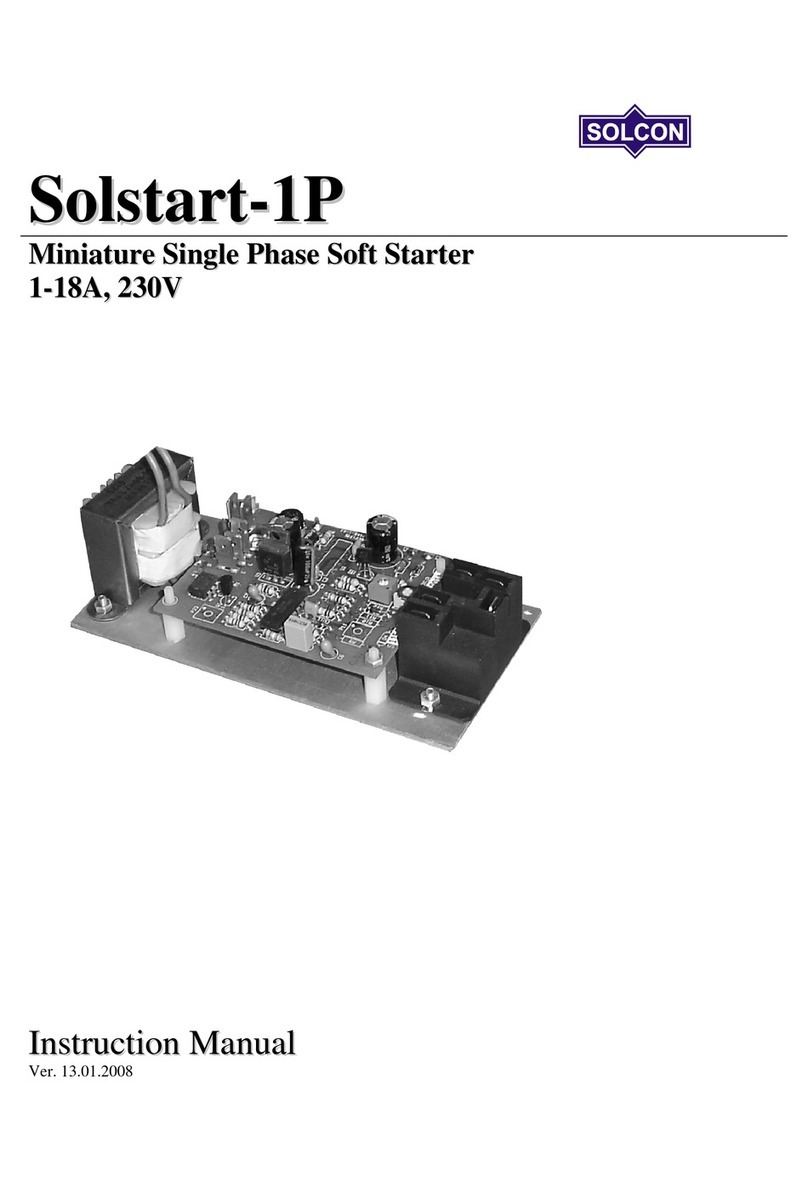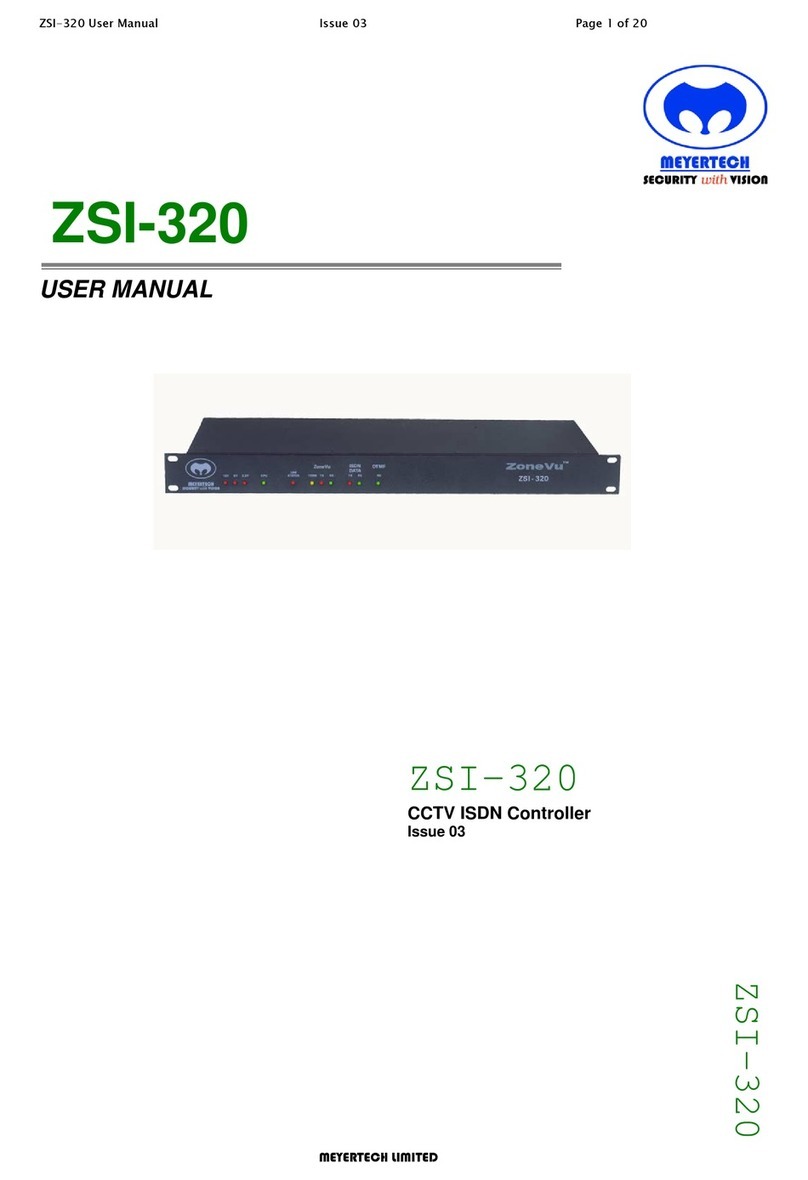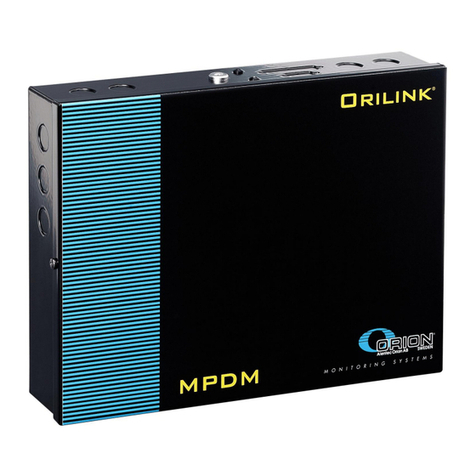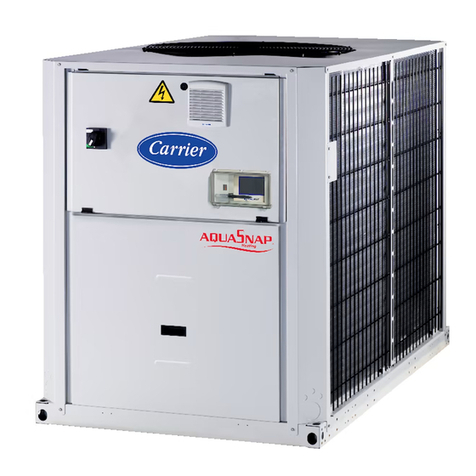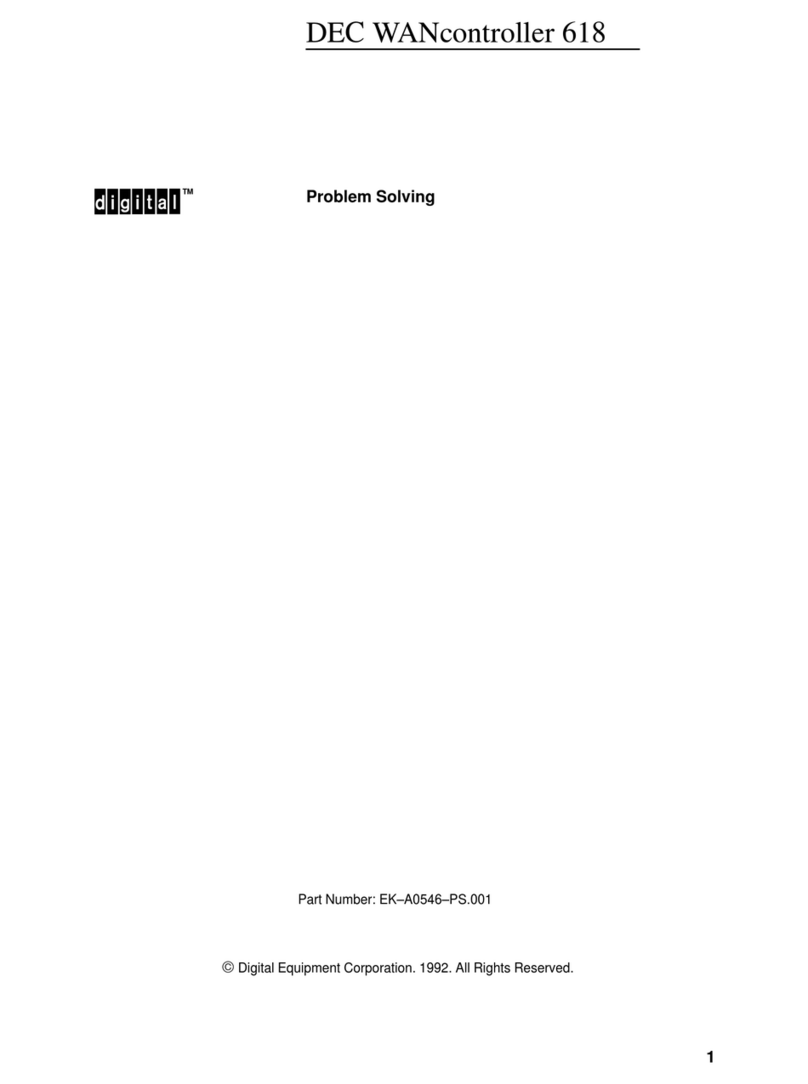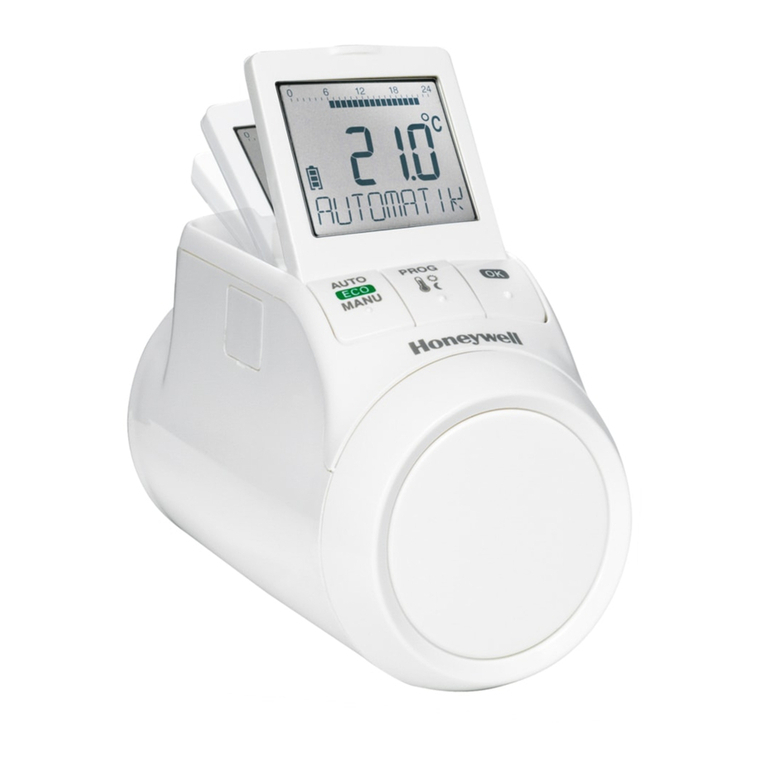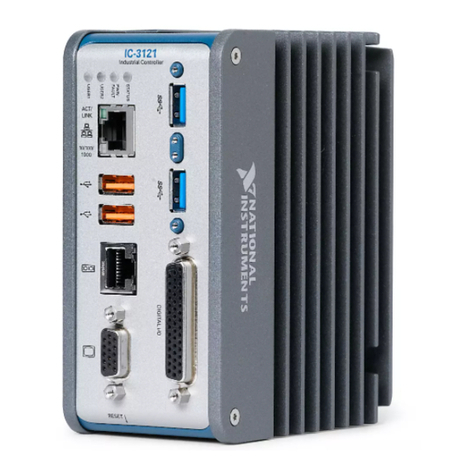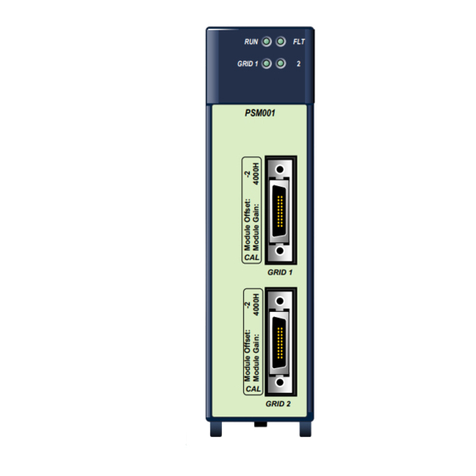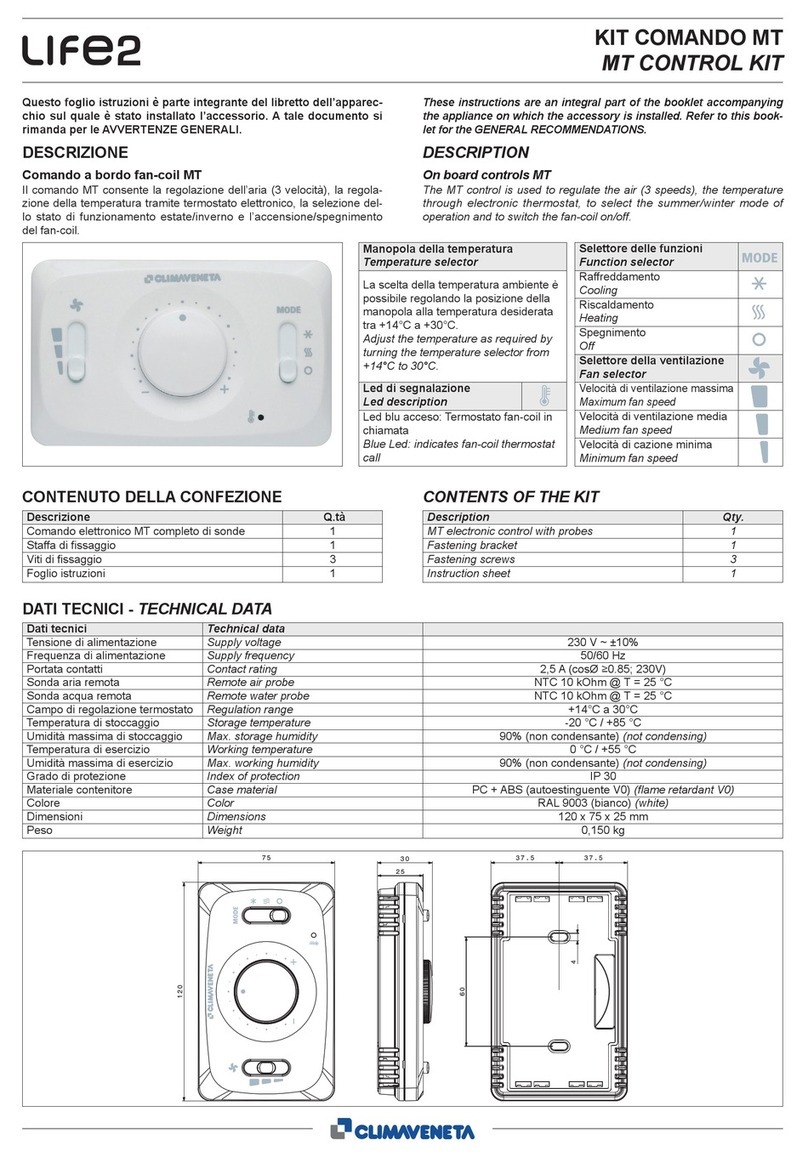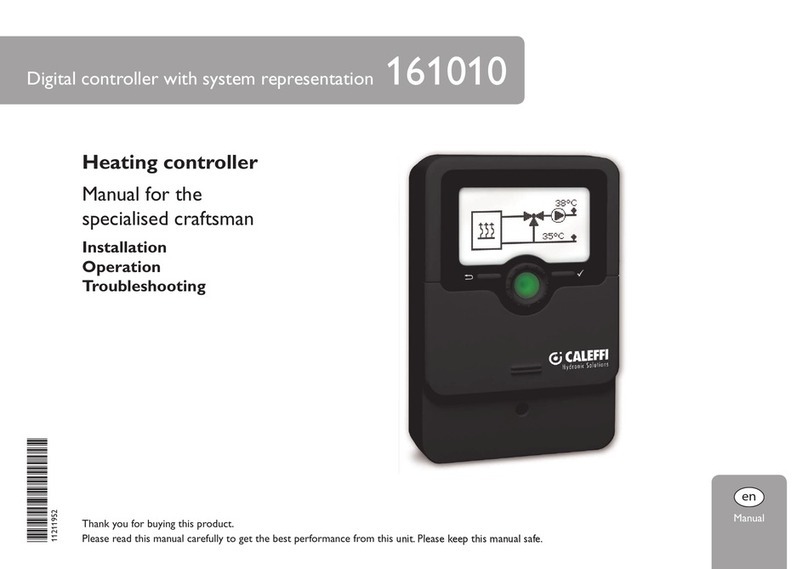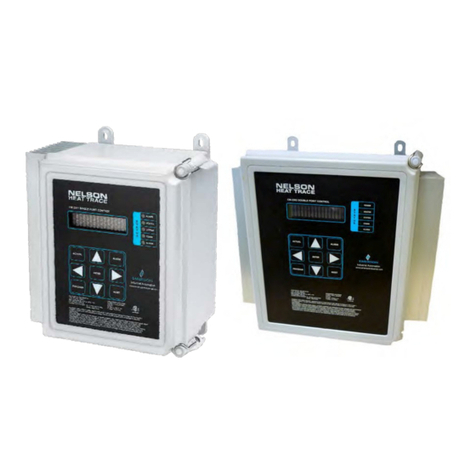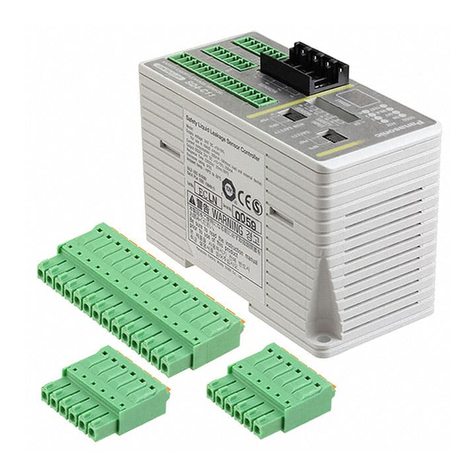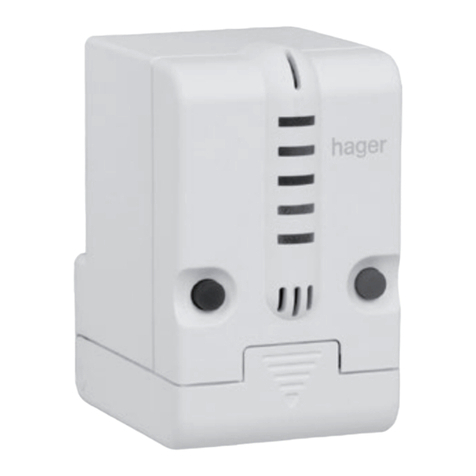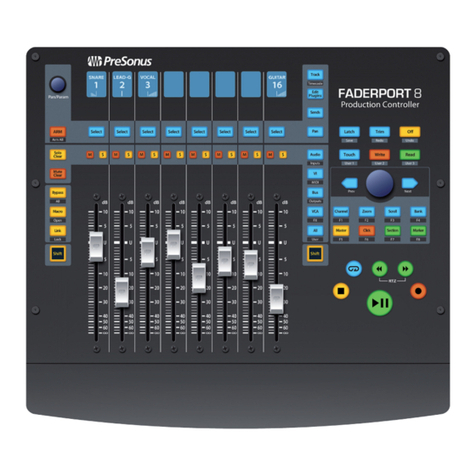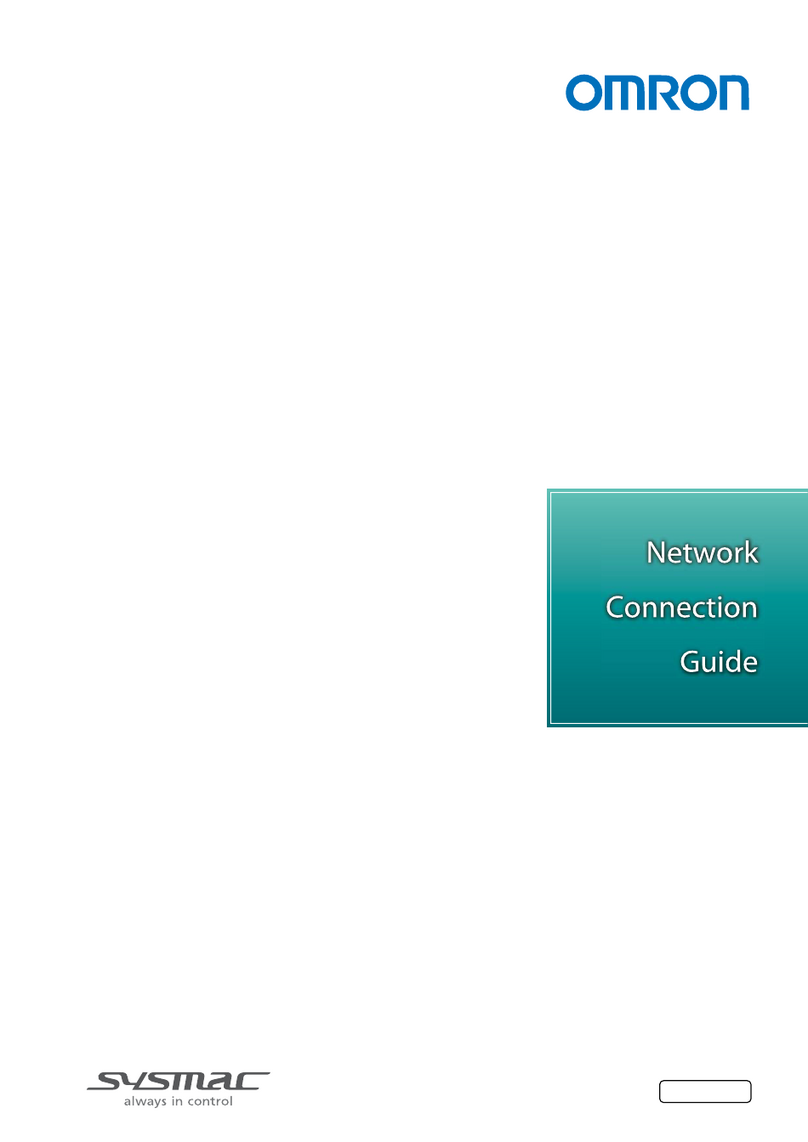Solcon RVS-DN 8 User manual

R
RV
VS
S-
-D
DN
N
D
Di
ig
gi
it
ta
al
l
S
So
of
ft
t
S
St
ta
ar
rt
te
er
r
8
8-
-3
30
00
00
0A
A,
,
2
22
20
0-
-1
12
20
00
0V
V
I
In
ns
st
tr
ru
uc
ct
ti
io
on
n
M
Ma
an
nu
ua
al
l
Ver. 14/06/2009

2 • Table of content
__________________________________________________________________________________
RVS-DN Instruction Manual
1. TABLE OF CONTENT
1. Table of content........................................................................................................................2
2. Safety & Warnings....................................................................................................................5
2.1 Safety..........................................................................................................................................5
2.2 Attention......................................................................................................................................5
2.3 Warnings.....................................................................................................................................5
3. Technical Data ..........................................................................................................................6
3.1 Introduction .................................................................................................................................6
3.2 Rated Currents and Frame Sizes ...............................................................................................8
3.3 RVS-DN Selection ......................................................................................................................8
3.3.1 Motor Current and Starting Conditions............................................................................8
3.4 Mains and Control Description....................................................................................................9
3.5 Input/Output Indication..............................................................................................................13
3.5.1 Preparation for Bypass Contactor .................................................................................14
3.5.1.1 Maintaining Current Protection after Bypass Closes..............................................14
3.5.1.2 Maintaining Current Protection after Bypass Closes - RVS-DN 950-3000a...........15
3.5.2 Input Terminal 7 - Energy Save/Slow Speed/Reset......................................................16
3.5.3 Input Terminal 8 - Dual Adjust/Reverse/Reset..............................................................16
3.5.4 Output Terminals 10, 11 & 12 – Immediate/Shear Pin Relay .......................................16
3.6 Ordering Information.................................................................................................................18
4. Recommended Wiring diagrams...........................................................................................19
4.1 Terminal 21 Connections With Various Mains..........................................................................19
4.2 Control Supply, Control Input and Mains are From the Same Source, Neutral Connected to
Terminal 21......................................................................................................................................20
4.3 Control Supply and Control Input From the Same Source, Neutral not Connected to Terminal 21
20
4.4 Control Supply and Control Input from Separate Sources........................................................21
4.5 Soft Start, Soft Stop and Stop, Control Supply and Control Input from the Same Source .......21
4.6 Soft Start, Soft Stop and Stop, Control Supply and Control Input from Separate Sources ......21
4.7 Soft Start and Immediate Stop (no Soft Stop) ..........................................................................22
4.8 Soft Start and Soft Stop ............................................................................................................22
4.9 Soft Start, Soft Stop and Immediate Stop.................................................................................22
4.10Energy Save, Slow speed or Reset ..........................................................................................23
4.11Slow Speed and Slow Speed Reverse .....................................................................................23
4.12External Fault............................................................................................................................24
4.13Line Contactor ..........................................................................................................................24
4.14Bypass Contactor .....................................................................................................................25
4.15Reversing with Two Line Contactors ........................................................................................26
4.16Operating via Communication Links .........................................................................................27
4.17D.ADJ.:GENERATOR PARAMETERS Wiring..........................................................................28
4.18Short Circuit Protection.............................................................................................................29
4.19Transient Protection..................................................................................................................29
4.20UL, cUL Installation Instructions ...............................................................................................29
4.21LR Recommendations for Marine, Off-shore or Industrial Use.................................................30
4.22Inside Delta Mode.....................................................................................................................30
4.22.1 General Information ......................................................................................................30
4.22.2 Notes on Inside Delta Connection.................................................................................31
4.22.3 Motor Connection and Terminals ..................................................................................31
4.22.4 RVS-DN Connected Inside Delta w/Bypass Contactor and Inside Delta Contactor .....32
4.22.5 RVS-DN Connected Inside Delta - Reverse Speed ......................................................33

3•Table of content
__________________________________________________________________________________________
5. Dimensions .............................................................................................................................34
5.1 Standard Models.......................................................................................................................34
5.1.1 Control Module Dimensions ..........................................................................................45
5.2 RVS-DN 1000V and RVS-DN 1200V Models...........................................................................46
5.3 UL/cUL/Marine Models .............................................................................................................47
6. Installation...............................................................................................................................54
6.1 Prior to Installation ....................................................................................................................54
6.2 Mounting ...................................................................................................................................54
6.3 Temperature Range & Heat Dissipation ...................................................................................54
6.3.1 Forced Ventilation .........................................................................................................55
6.3.2 Calculating the Enclosure Size, for Non-Ventilated Metal Enclosure............................55
6.4 Main PCB and Optional PCBs ..................................................................................................55
6.5 Dip Switch Settings on the Main PCB.......................................................................................56
6.5.1 Switch # 1 – Display Modes ..........................................................................................56
6.5.2 Switch # 2 – Tacho Feedback (0-10VDC).....................................................................57
6.5.3 Switch # 3 – Main/D.ADJ.:GENERATOR PARAMETERS............................................57
6.5.4 Switches # 5, 6 – Language Selection ..........................................................................57
6.5.5 Switch # 7 – Expanded Settings ...................................................................................58
6.5.6 Switch # 8 – Software Lock...........................................................................................58
6.6 Internal Fan Control ..................................................................................................................58
6.7 Analog I/O (Option 5) (Terminals T1, T2, Gnd, Out (-), Out (+))..............................................59
6.8 Remote Key-Pad Installation ....................................................................................................60
7. Control Keypad.......................................................................................................................61
7.1 LCD Arrangement.....................................................................................................................61
7.2 Push-Buttons ............................................................................................................................61
7.3 Status LEDs..............................................................................................................................62
7.4 Reviewing and Modifying Parameters ......................................................................................62
7.5 Special Actions Performed in TEST/MAINTENANCE Mode ....................................................62
7.5.1 Run Self Test ................................................................................................................62
7.5.2 View Software Version ..................................................................................................63
7.5.3 Obtain Default Parameters............................................................................................63
7.5.4 Reset Statistical Data....................................................................................................63
7.5.5 Calibrate Voltage and Current (Factory Use Only!) ......................................................64
7.5.6 TEST/MAINTENANCE in RVS-DN 1000V and RVS-DN 1200V...................................64
7.6 Mode Pages..............................................................................................................................65
7.7 Overview of All Mode Pages and Factory Defaults ..................................................................66
7.7.1 Display Mode – Page 0 .................................................................................................68
7.7.2 Main Parameters – Page 1 ...........................................................................................69
7.7.2.1 Overload Calculation..............................................................................................71
7.7.3 Start Parameters – Page 2............................................................................................72
7.7.3.1 Soft Start Parameters.............................................................................................75
7.7.4 Stop Parameters – Page 3............................................................................................77
7.7.4.1 Soft Stop Parameters.............................................................................................78
7.7.5 Dual Adjustment Parameters – Page 4.........................................................................79
7.7.6 Energy Save & Slow Speed Parameters – page 5 .......................................................80
7.7.7 Fault Parameters – Page 6 ...........................................................................................81
7.7.8 I/O Programming Parameters – Page 7........................................................................83
7.7.8.1 Terminal 7 and 8 Programming..............................................................................84
7.7.9 Comm. Parameters – Page 8 – With the Modbus Card................................................85
7.7.10 Comm. Parameters – Page 8 – With the Profibus Card ...............................................85
7.7.11 Statistical Data – page 9 ...............................................................................................86
7.8 Non Adjustable Protection and Fault Reset..............................................................................87
7.8.1 Under/Over Frequency..................................................................................................87
7.8.2 Phase Loss ...................................................................................................................87
7.8.3 Phase Sequence...........................................................................................................87
7.8.4 Wrong Connection ........................................................................................................87
7.8.5 Shorted SCR .................................................................................................................87

4 • Table of content
__________________________________________________________________________________
7.8.6 Heat-Sink Over Temperature ........................................................................................87
7.8.7 External Fault ................................................................................................................87
7.8.8 Fault and Reset.............................................................................................................87
7.8.9 Auto Reset ....................................................................................................................88
7.9 Timing Occurrence Table .........................................................................................................88
8. Starting Procedure .................................................................................................................89
8.1 Standard Starting Procedure ....................................................................................................90
8.2 Examples of Starting Curves ....................................................................................................91
8.2.1 Light Loads - Pumps, Etc. .............................................................................................91
8.2.2 High Inertia Loads: Crushers, Centrifuges, Mixers, Etc. ...............................................91
8.2.3 Special Starting Using DUAL ADJUSTMENT ...............................................................92
8.2.3.1 Special Starting – Using DUAL ADJUSTMENT – Wiring Diagram ........................92
8.2.4 Choosing a Suitable Pump Curve (Centrifugal Pumps) ................................................93
8.2.4.1 Starting Curve ........................................................................................................93
8.2.4.2 Stopping Curve ......................................................................................................93
8.2.4.3 FINAL TORQUE During Soft-Stopping a Pump Motor...........................................94
9. Trouble Shooting....................................................................................................................95
9.1 Warranty Claim and Fault Inquiry .............................................................................................98
10. Technical Specifications........................................................................................................99

5 • Safety & Warnings
__________________________________________________________________________________________
2. SAFETY & WARNINGS
2.1 Safety
1 Read this manual carefully before operating the equipment and follow its
instructions.
2 Installation, operation and maintenance should be in strict accordance
with this manual, national codes and good practice.
3 Installation or operation not performed in strict accordance with these
instructions will void manufacturer’s warranty.
4 Disconnect all power inputs before servicing the soft starter and/or the
motor.
5 After installation, check and verify that no parts (bolts, washers, etc.)
have fallen into the power section of the RVS-DN.
6
During shipping, the RVS-DN might have been roughly handled,
therefore, it is recommended to initialize the RVS-DN by connecting
supply voltage prior to operating the RVS-DN with a motor.
2.2 Attention
1 This product was designed for compliance with IEC 60947-4-2 for class A
equipment.
2 RVS-DN 8 - 820 are UL approved (when this option is specified). RVS-
DN 950 - 3000 are designed to meet UL requirements.
3
RVS-DN 8 - 1400 are LR approved (when this option is specified). RVS-
DN 1800 - 3000 are designed to meet LR requirements (when this option
is specified).
4
Use of the product in domestic environments may cause radio
interference, in which case the user may be required to employ additional
mitigation methods.
5 Utilization category is AC-53a or AC53b, Form 1. For further information,
see Technical Specification.
2.3 Warnings
1
Internal components and PCBs are at mains potential when the RVS-DN
is connected to mains. This voltage is extremely dangerous and contact
with it will cause death or severe injury.
2
When the RVS-DN is connected to mains full voltage may appear on the
RVS-DN’s output terminals and motor’s terminals, even if control
voltage is disconnected and motor is stopped.
3 The RVS-DN must be grounded to ensure correct operation, safety and
to prevent damage.
4 Check that Power Factor capacitors are not connected to the output side
of the RVS-DN.
5 Do not interchange line and load connections.
The company reserves the right to make any improvements or modifications to its products without
prior notice.

6 • Technical Data
_____________________________________________________________________________________________
3. TECHNICAL DATA
3.1 Introduction
The RVS-DN is a highly sophisticated and reliable soft starter designed for use with standard three-phase,
three-wire and six-wire, squirrel cage induction motors. It provides the best method of reducing current and
torque during motor starting.
The RVS-DN starts the motor by supplying a slowly increasing voltage to the motor. This provides soft start
and smooth, stepless acceleration while drawing the minimum current necessary to start the motor.
The third generation, microprocessor based digital control provides unique features like pump control, slow
speed, electronic reversing and accurate motor protection. RVS-DN models can be supplied with options for
insulation protection, thermistor input & analog output, etc.
The optional RS 485 Communication with Modbus protocol or the optional Profibus protocol enables full
control (START, STOP, DUAL ADJUST, Command, etc.) and supervision.
Advantages at a Glance
Complete line 8-3000A, 220-1200V
Heavy duty, fully rated design
Robust construction
Superior starting & stopping characteristics
Comprehensive motor protection package
User friendly
Line or Inside Delta connection
Rated ambient temperature: 50°C
Unique optional features including:
Motor insulation tester
RS 485 comm. Modbus / Profibus
Thermistor input / analog output
Starting & Stopping
Soft start & soft stop
Current limit
Pump control program
Torque and current control for optimized
starting & stopping process
Dual adjustments - two starting & stopping
characteristics
Slow speed with electronic reversing
Pulse start
Linear acceleration (tacho feedback)
Energy Save for improved power factor
Standard Ratings
230V, 400V, 480V, 600V, 690V, 1000V, 1200V
Motor & Starter Protection
Too many starts
Long start time (stall)
Shear-pin
Electronic overload with selectable curves
Under current with adjustable delays
Phase loss & phase sequence
Under, over & no voltage
Load loss (motor not connected)
Shorted SCR
Starter over-temperature
Displays LCD & LEDs
Illuminated LCD - 2 lines x 16 characters
Selectable languages: English, German,
French
and Spanish (Russian - optional)
Two display modes for basic and advanced
applications
Friendly operation with default parameters
Eight LEDs for quick operational status
Statistical data including:
Total run time
Total number of starts
Total number of trips
Last start current
Last start time
Last trip
Current at trip

7 • Technical Data
________________________________________________________________________________________________
Options
Analog output (see details below)
Thermistor input (see details below)
Motor insulation test (see details below)
Preparation for bypass - to maintain
protection when bypass is closed
Special anti-corrosive treatment - special coating
for harsh environments
Special tacho feedback circuitry
Modbus RTU - enables setting, control &
supervision
Profibus DP – enables setting, control &
supervision
Analog Card (Optional)
Incorporates two functions:
Thermistor input, PTC or NTC
Analog output, related to motor's current,
programmable as 0-10VDC, 4-20mA, 0-20mA or
inverse (inverse available in RVS-DN 1000V& RVS-
DN1200V models)
Motor Insulation Tester (Optional)
A unique feature for submersible pumps, motors
installed in harsh environments, etc.
The system measures motor insulation when motor is
not running.
Two programmable levels are available:
Alarm level, adjustable 0.2-5 Mohm
Start disable level, adjustable 0.2-5 Mohm,
preventing starting when insulation is below
acceptable levels
Auxiliary Relays
Three standard programmable relays (each relay with
one C.O. 8A, 220VAC contacts)
Immediate with adjustable on and off delays.
Can be dedicated for shear-pin (jam) protection
End of acceleration, with adjustable on delay
Fault, programmable as fault or fault-fail safe
operation.
Low motor insulation alarm (optional relay)
Applications - Industrial
Pumps
Hydraulic systems
Fans and blowers
Compressors
Conveyors
Applications - Marine & Offshore
Water, ballast and fire-fighting pumps
Refrigeration chillers and compressors
Hydraulic pumps and power packs
Thrusters
Main propulsion motors
Unique protection for corrosive environments
Generator ready - auto frequency tracking
Sustains variations of 45-65Hz while starting
Heavy duty, fully rated design
Applications - 1000V &1200V for Mining,
Quarries & Mixers
Digital Soft Starter for 105-460A, robust, heavy
duty, fully featured, fiber-optically controlled
(210-460A)
Stainless steel with copper heatsink is available
below 100A – consult factory for details
The RVS-DN has Lloyds Type Approval for
ENV1, ENV2. As well as, Germaniche Lloyds,
Rina and DNV - consult factory for details

8 • Technical Data
_____________________________________________________________________________________________
3.2 Rated Currents and Frame Sizes
RVS-DN Model
RVS-DN
FLC
[A]
Frame
Size
Dimensions WxHxD
[mm]
Weight
[Kg]
RVS-DN 8 8 A 153x310x170 4.5
RVS-DN 17 17 A 153x310x170 4.5
RVS-DN 31 31 A 153x310x170 6.0
RVS-DN 44 44 A 153x310x217 7.5
RVS-DN 58 58 A 153x310x217 7.5
RVS-DN 72 72 A 153x310x217 7.5
RVS-DN 85 85 B 274x385x238 14.5
RVS-DN 105 105 B 274x385x238 14.5
RVS-DN 145 145 B 274x385x238 14.5
RVS-DN 170 170 B 274x385x238 14.5
RVS-DN 210 210 C380x455x292 (1) 32
RVS-DN 310 310 C380x455x292 (1) 32
RVS-DN 390 390 C380x455x292 (1) 32
RVS-DN 460 460 D 380x555x292 (1) 39
RVS-DN 580 580 D 470x640x302 (1)
470x655x302 (2) 48
RVS-DN 820 820 D 470x710x302 (1)
470x715x302 (2) 65
RVS-DN 950 950 D 623x660x290 (3) 83.5
RVS-DN 1100 1100 E723x1100x370 (3) 170
RVS-DN 1400 1400 E 723x1100x370 (3) 170
RVS-DN 1800 1800 E 723x1100x370 (3) 170
RVS-DN 2150 2150 F 750x1300x392 (3) 240
RVS-DN 2400 2400 G 900x1300x410 (3) (4) 350
RVS-DN 2700 2700 G 900x1300x410 (3) (4) 350
RVS-DN 3000 3000 G900x1300x410 (3) (4) 350
RVS-DN 105 1000V 105 325x400x300 (5)
RVS-DN 170 1000V, 1200V 170 592x500x345 (5)
RVS-DN 210 1000V, 1200V 210 592x500x345 (5)
RVS-DN 310 1000V, 1200V 310 592x500x345 (5)
RVS-DN 390 1000V, 1200V 390 592x500x345 (5)
RVS-DN 460 1000V, 1200V 460 592x500x345 (5)
3.3 RVS-DN Selection
The RVS-DN should be selected in accordance with the criteria of motor current and starting conditions.
3.3.1 Motor Current and Starting Conditions
Select the RVS-DN according to motor's Full Load Ampere (FLA) - as indicated on its nameplate (even if the
motor will not be fully loaded).
The RVS-DN is designed to operate under the following maximum conditions:
Ambient
Temperature
[°C]
Starting Current
[A]
Acceleration
Time
[sec]
50 400%xIn 30
Max. starts per hour: 4 starts per hour at maximum ratings and up to 60 starts per hour at light load
applications (consult factory).
Note:
For very frequent starts (inching applications) the inching current should be considered as the Full Load
Current (FLC) (consult factory).
Notes:
(1) – Different dimensions when ordered with UL/cUL/marine approvals.
Refer to section 5.3 page 47 for dimensions when ordered with these approvals.
(2) – Dimensions with preparation for bypass.
(3) – Must be operated with bypass contactor. Add space for current transformers and bus
bars for preparation for bypass.
(4) – Control module is installed separately. Refer to section 5.1.1 page 45 for dimensions.
(5) – Consult factory.
Refer to section 5 on page 34 for detailed dimensions.

9 • Technical Data
________________________________________________________________________________________________
3.4 Mains and Control Description
Refer to drawing on page 13
Indication Description Remarks
L1, L2, L3 Connection to mains voltage up to
1200V
Thyristor’s PIV rating, internal circuitry and insulation
defines five voltage levels:
400V for 230-400V +10%/ -15% 50/60Hz
480V for 480V +10% /-15% 50/60Hz
600V for 600V +10% /-15% 50/60Hz
690V for 690V +10% /-15% 50/60Hz
1000V for 1000V +10% / -15% 50/60Hz
1200V for 1200V +10% / -15% 50/60Hz
Each RVS-DN is suitable for one of the above levels
& for 50/60 Hz.
L1b, L2b, L3b Preparation for bypass
connection (optional)
All models from RVS-DN 950A and up, RVS-DN
1000V and RVS-DN 1200V models must be
operated with a bypass contactor.
Bypass preparation is standard in models RVS-
DN85-170A.
Refer to section 3.5.1 page 14 for more details.
U, V, W Connection to motor
G Connection to ground For proper operation and for safety reasons soft
RVS-DN must be properly grounded.
Terminal 1 Control phase (positive – for DC
control)
The control voltage operates the electronic circuitry
and the fans (when they exist).
Terminal 3 Control neutral (return) Three control voltages are available:
115 for 115V +10%/ -15% 50/60Hz
230 for 230V +10%/ -15% 50/60Hz
110VDC for 110V +10%/ -15% DC
Terminal 2 Fan control An internal jumper, connected between the fan and
terminal 2 enables three modes of operation (refer to
section 6.6 page 58).
For fan power consumption, see technical
specification in section 10 page 99.
Terminal 4 Input – STOP command.
•Input from a N.C. contact
•To stop the motor, disconnect
Control Input voltage from
terminal 4 for at least 250mSec.
(no SOFT STOP)
•Control Input voltage (STOP, SOFT STOP,
START, terminal inputs 7 and 8) can be the same
as Control Supply (terminals 1, 3) or voltage from a
different source.
•The Control Inputs are opto-coupled and isolated
from the microprocessor circuitry.
Terminal 5 Input – SOFT STOP command.
•Input from a N.C. contact
•To SOFT STOP the motor
disconnect Control Input voltage
from terminal 5 for at least
250mS
Note:
If SOFT STOP is not required,
connect a jumper between
terminals 4 and 5.
Control Input voltages available:
230 for 90-230V +10%/ 50/60Hz or DC.
24 for 24V +10%/ -15% 50/60Hz or DC.
48 for 48V +10%/ -15% 50/60Hz or DC.

10 • Technical Data
_____________________________________________________________________________________________
Indication Description Remarks
Terminal 6 Input – START command.
•Input from a N.O. contact.
•To SOFT START the motor,
connect Control Input voltage to
terminal 4 for at least 250mSec.
Notes:
•Motor will start only if STOP
(terminal 4) and SOFT STOP
(terminal 5) terminals are
connected to Control Input
voltage.
•To reset a fault the START
command must be removed.
Terminal 7 Programmable input –
ENERGY SAVE / SLOW
SPEED / RESET
Refer to section 3.5.2 page 16.
Terminal 8 Programmable input –
DUAL ADJUSTMENT /
REVERSING / RESET
Refer to section 3.5.3 page 16.
Terminal 9 Common to terminals 4-8.
This terminal is a reference for terminals 4, 5, 6, 7 &
8.
Note:
When Control Supply and Control Input voltage are
from the same source, connect a jumper between
terminals 3 and 9.
Terminal 10 Programmable IMM/S.PIN
RELAY (N.O.)
IMM/S.PIN RELAY is the immediate/shear pin output
relay.
•
Terminal 11 Programmable IMM/S.PIN
RELAY (N.C.)
•Voltage free 8A, 250VAC, 2000VA max.
•Selection between functions is made from the
keypad or through the communication.
Terminal 12 Programmable IMM/S.PIN
RELAY (Common)
•Refer to section 7.7.8 page 83 for IMM/ S.PIN
RELAY programming.
•Refer to section 3.5.4 page 16 for more details.
Terminal 13 Programmable Fault
Output relay (N.O.)
Voltage free 8A, 250VAC, 2000VA max. changes its
position upon fault.
Terminal 14 Programmable Fault
Output relay (N.C.)
The contact is programmable to function as FAULT
or FAULT-FAIL SAFE.
Terminal 15 Programmable Fault
Output relay (Common)
When the FAULT function is selected, the relay is
energized upon fault. The contact returns to its
original position when one of the following occurs:
•The fault has been removed and RVS-DN was
reset
•Disconnection of Control Supply
When the FAULT-FAIL SAFE function is selected,
the relay is energized immediately when the Control
Supply is connected and de-energizes when one of
the following occurs:
•Fault
•Control Supply disconnection
Refer to section 7.7.8 page 83 for FAULT RELAY
TYPE programming.

11 • Technical Data
________________________________________________________________________________________________
Indication Description Remarks
Terminal 16 Programmable End of
Acceleration (Run) Output relay
(N.O.)
Voltage free 8A, 250VAC, 2000VA max. changes its
position at the end of acceleration, after an
adjustable time delay (Contact Delay), 0 – 120 sec.
Terminal 17 Programmable End of
Acceleration (Run) Output relay
(N.C.)
The contact returns to its original position when
ENERGY SAVE is operated, on SOFT STOP or
STOP signals, on FAULT condition, or upon voltage
outage.
Terminal 18 Programmable End of
Acceleration (Run) Output
relay (Common)
The End of Acceleration contact (Run) can be used
for:
•Closing a bypass contactor
•Activating a valve after compressor has reached full
speed
•Loading a conveyor after motor reached full speed.
Refer to section 7.7.3 page 72 for RUN CONTACT
DELAY programming
Terminal 19 External Fault input Input from a N.O. contact that is connected between
terminals 19 and 21. The RVS-DN will trip 2 seconds
after the contact closes.
Notes:
•Wires connecting the External Fault contact to
terminal 19 should not exceed 1 meter in length.
•External Fault can be used only when terminal 21 is
connected to neutral or ground.
•Do not use External Fault while using the Insulation
Alarm option.
•Only potential free contacts may be connected to
terminal 19.
•Do not connect any voltage to terminal 19.
•Any connection of voltage to this terminal may
disrupt RVS-DN operation, and cause RVS-DN or
motor damage.
•Refer to section 4.12 page 24 for the External Fault
wiring diagram.
Terminal 20 Tacho Feedback input (optional) •Provides linear acceleration and deceleration.
•Requires high quality tacho generator on motor
shaft, output voltage 0-10VDC, linear
speed/voltage ratio.
•Consult factory for further information before using
the tacho feedback feature.
Terminal 21 Neutral connection When a mains neutral wire is available, connect
terminal 21 to neutral. Terminal 21 serves only as a
voltage reference to the control circuitry.
Notes:
•RVS-DN circuitry incorporates an internal artificial
neutral, which should only be used, when the
system is not grounded and mains neutral
connection is not available.
•Only potential free contacts may be connected to
terminal 21.
•Do not connect any voltage to terminal 21.
Any connection of voltage to this terminal may
disrupt RVS-DN operation, and cause RVS-DN or
motor damage.
•Refer to section 14.1 on page 19 for terminal 21
connection.

12 • Technical Data
_____________________________________________________________________________________________
Indication Description Remarks
Terminal 22 No connection (optional) •Standard RS485, half duplex with Modbus protocol,
baud rate 1200, 2400, 4800, 9600 BPS.
Terminal 23 RS-485 communication (-)
(optional)
•Twisted shielded pair should be used.
Connect shield to ground on the PLC/Computer
side.
Terminal 24 RS-485 communication (+)
(optional)
•Terminals 4 & 5 must be wired to Control Supply for
operation in communication mode (refer to section
4.16 page 27 for wiring diagram).
•Up 32 units can be connected for Modbus RS485
communication. For reliable communication, units
should be installed in the vicinity of 200m
maximum, from the first to the last unit.
•Refer to section 7.7.9 page 85 for programming.
•Consult the communication manual (ask factory).
Terminal 25 Programmable Insulation Alarm
Output relay (Common) (optional)
Voltage free 8A, 250VAC, 2000VA max. is energized
when the motor insulation level decreases below the
Insulation Alarm level.
Terminal 26 Programmable Insulation Alarm
Output relay (N.O.) (optional)
The relay is de-energized and the alarm will
disappear if on of the following occurs:
•The insulation level returns to normal for more than
60 seconds
•RVS-DN resets
•Control Supply disconnection
Refer to section 7.7.7 on page 81 for more details.
Terminal 27 Programmable Insulation
Alarm Output relay (N.C.)
(optional)
Notes:
•Do not use External Fault while using Insulation test
option.
•Insulation test can be performed only when main
voltage is not connected to the RVS-DN,
(upstream isolation device must be opened.)
•For correct operation of Insulation test, it is
important that the RVS-DN is properly grounded
and that the control module is properly fastened to
the power section.
•Insulation test option and analog output option can
not be applied together.
•Refer to section 7.7.7 page 81 for insulation test
programming.
Terminal 28 Thermistor input (T1) (optional) Thermistor input is programmable as a PTC or NTC
type thermistor. The trip value is adjustable between
1-10Kohm, preset delay of 2 Sec.
Terminal 29 Thermistor input (T2) (optional) Connect thermistor and/or Analog output shield to
ground terminal.
Terminal 30 Ground (optional) Analog output (0-10VDC or 0-20mA or 4-20mA)
Terminal 31 Analog output (-) (optional) reflects motor current and is related to 2xFLA. i.e.,
Full scale (10VDC or 20mA) is related to 2xFLA.
Terminal 32 Analog output (+) (optional) Note:
In the RVS-DN 1000V & 1200V models the analog
output reflects motor current and is related to
2xFLC.Dip switches allow selection between: 0-
10VDC, 0-20mA or 4-20mA.
•Refer to section 6.7 page 59 for analog output dip
switch setting.
•Refer to section 7.7.8 page 83 for analog output
programming.
•Refer to section 7.7.7 page 81 for thermistor input
programming.

13 • Technical Data
________________________________________________________________________________________________
Indication Description Remarks
D-9 connector Profibus communication (optional) •Profibus DPV0 and DPV1, up to 12 MBPS.
•D type 9 pin connector is applied.
•Control, monitoring and setting parameters can be
achieved via the Profibus connection.
•Setting is possible only when DPV1 is
implemented.
•Refer to section 7.7.10 page 85 for programming.
•Consult the Profibus manual (request from the
factory).
3.5 Input/Output Indication

14 • Technical Data
_____________________________________________________________________________________________
3.5.1 Preparation for Bypass Contactor
Under normal operating conditions the heat dissipated by an RVS-DN causes heating of the enclosure and
energy losses. The heating and losses can be eliminated by the use of a bypass contactor, which bypasses
the RVS-DN after completion of start-up so that motor current will flow through the bypass contactor.
In models RVS-DN 950A and up, current transformers CT1 and CT2 are mounted outside the RVS-DN and
need to be connected to the RVS-DN by the customer. In this case the customer MUST NOT ground the
secondaries of current transformers!
Heat dissipation from the RVS-DN is calculated as:
Ploss=3x1.3xI+FAN loss
where:
I represents motor current. Note that the motor current during the start process is higher than the motor rated
current.
FAN loss represents power loss caused by all internal fans (refer to section 10 page 99 for fan loss per
model).
For example, during start of a 820A motor when CURRENT LIMIT is set to 400%, heat dissipation can be
calculated as:
Ploss=3x1.3x4x820+150=12,792Watt≈12.8kW
While a 820A motor is running and the motor current is 820A, heat dissipation can be calculated as:
Ploss=3x1.3x820+150=3,198Watt≈3.2kW
When a bypass contactor is used this changes the previous calculation to:
Ploss=3x1.3x0+150=150Watt≈0.15kW
It is obvious that using a bypass contactor can significantly reduce energy consumption.
Notes:
•All models from RVS-DN 950A and up, RVS-DN 1000V and RVS-DN 1200V must be implemented with a
bypass contactor (see section 3.5.1.2 page 15).
•Bypass preparation is standard in models RVS-DN 85-170A.
3.5.1.1 Maintaining Current Protection after Bypass Closes
Current flow during soft start and soft stop.
Bypass contactor is open.

15 • Technical Data
________________________________________________________________________________________________
Current flow during RUN when the bypass contactor bypasses the RSV-DN.
Current transformers CT1 and CT2 are able to measure motor current, thus the motor current
protections of the RVS-DN are operable.
Note:
If the RVS-DN is bypassed without using the preparation for bypass the following protections are not operable
during RUN:
•UNDER CURRENT
•O/C SHEAR PIN
•OVERLOAD TRIP
3.5.1.2 Maintaining Current Protection after Bypass Closes - RVS-DN 950-3000a
RVS-DN 950-3000A models are supplied without preparation for bypass. However bypass must be applied
for these models.
Current transformers CT1 and CT2 are supplied separately and must be connected to the RVS-DN as shown
below.
Note:
Do not ground current transformers secondaries!
Current flow during RUN when the bypass contactor bypasses the RVS-DN. The customer
must perform the bypass connections shown.
Current transformers CT1 and CT2 are supplied with the RVS-DN. Do NOT ground the CTs!

16 • Technical Data
_____________________________________________________________________________________________
3.5.2 Input Terminal 7 - Energy Save/Slow Speed/Reset
Input from a N.O. contact - selection between above functions is made from the keypad (refer to section
7.7.8 page 83) or through the communication (Modbus or Profibus).
When ENERGY SAVE function is selected - connect terminal 7 to control input voltage by a jumper for
automatic operation, upon load decrease.
When connected through a N.O. contact, closing the contact operates Energy Save.
When SLOW SPEED function is selected - connect control input voltage to terminal 7 before starting. When
start command is initiated motor will run at 1/6 nominal speed for 30 seconds maximum. Closing terminal 7
while motor is running will not have any effect.
When RESET function is selected - connect terminal 7 to control input voltage (use a N.O. momentary
contact) to reset the RVS-DN.
Refer to section 4.10 page 23 for the wiring diagram.
3.5.3 Input Terminal 8 - Dual Adjust/Reverse/Reset
Input from a N.O. contact - selection between above functions is made from the keypad (refer to section
7.7.8 page 83) or through the communication (Modbus or Profibus).
When DUAL ADJUSTMENT function is selected - connect terminal 8 to Control Input voltage to operate the
RVS-DN with the DUAL ADJUSTMENT characteristic. DUAL ADJUSTMENT characteristic is programmed as
explained in section 7.7.5 page 79. You can switch between the primary and DUAL ADJUSTMENT settings
before and/or during starting.
When dip switch #3 is set to on, DUAL ADJUSTMENT operates as D.ADJ.:GENERATOR PARAMETERS.
Use this mode if the normal starting process fails, i.e., SHORTED SCR or WRONG CONNECTION faults
occur and, after testing, operator is sure that SCRs, motor and motor connections are not faulty.
Refer to section 4.17 page 29 for D.ADJ.:GENERATOR PARAMETERS wiring.
Refer to section 9 page 95 for trouble shooting.
When SLOW SPEED REVERSE function is selected - connect Control Input voltage to terminal 8 to reverse
direction. In order to operate in SLOW SPEED REVERSE, terminal 7 must be programmed as SLOW SPEED
and Control Input voltage must be connected to terminal 7 as well.
You can give the reverse command before the motor is started or during operation at SLOW SPEED.
Connecting Control Input voltage to terminal 8 before motor is started, starts the motor in reverse direction.
Connecting Control Input voltage while motor is running at SLOW SPEED stops the motor for 0.6 – 2 sec
(according to motor size) before reversing its direction.
Refer to section 4.10 page 23 for wiring diagram.
When RESET function is selected - connect terminal 8 to Control Input voltage (use a N.O. momentary
contact) to reset the RVS-DN.
Refer to section 4.10 page 23 for the wiring diagram.
3.5.4 Output Terminals 10, 11 & 12 – Immediate/Shear Pin Relay
Programmable functions (refer to section 7.7.8 page 83):
IMMEDIATE (after start signal) - when immediate is selected, the relay is energized upon the START signal.
The relay is de-energized when one of the following occurs:
•Fault
•Control Supply outage
•STOP signal
When SOFT STOP is operated - the relay is de-energized at the end of the SOFT STOP process.
The relay incorporates on and off delays of 0-3600 sec. each.
The immediate relay can be used for the following purposes:
•Release a brake of a motor
•Interlock with other systems

17 • Technical Data
________________________________________________________________________________________________
•Signalling
•Delay the opening of a line contactor at the end of SOFT STOP, thus allowing current to decrease to zero
before opening the contactor
•Switch to / from Dual Adjustment settings with a time delay from the START signal (see Special Starting
section 8.2.3.1 page 92).
O/C SHEAR PIN detection - when O/C Shear-pin is selected, the relay is energized upon SHEAR-PIN
detection (RVS-DN’s trip can be delayed 0-5 sec).
In this case, the relay incorporates on and off delays of 0-5 sec. each.
The O/C SHEAR PIN relay can be used for the following purposes:
•Interlock with other systems
•Signalling
•Delay for operating a reversing combination of upstream contactors when SHEAR PIN is detected, thus
allowing clearing of a jam condition.

18 • Technical Data
_____________________________________________________________________________________________
3.6 Ordering Information
RVS-DN 31- 400- 230 230- 0- S
Full load Current Mains Voltage Control Supply
Voltage
Control Input
Voltage
Options Front Panel
Full load Current
Specify Description
RVS-DN’s
FLC [A]
8, 17, 31, 44, 58, 72, 85(2), 105(2), 145(2), 170(2), 210, 310, 390, 460, 580, 820, 950(1), 1100(1),
1400(1), 1800(1), 2150(1), 2400(1), 2700(1), 3000(1).
Mains Voltage
Specify Description
400 230 – 400 VAC, +10% -15%, 50/60Hz
480 480 VAC, +10% -15%, 50/60Hz
600 600 VAC, +10% -15%, 50/60Hz
690 690 VAC, +10% -15%, 50/60Hz
1000(1) 1000 VAC +10% -15%, 50/60Hz; Models: 105A, 170A, 210A, 310A, 390A, 460A.
1200(1) 1200 VAC +10% -15%, 50/60Hz; Models: 170A, 210A, 310A, 390A, 460A.
Control Supply Voltage (Terminals 1 and 3)
Specify Description
115 115 VAC, 50/60Hz, +10% -15%
230 230 VAC, 50/60Hz, +10% -15%
110VDC 110 VDC, +10% -15%
Control Input Voltage (Terminals 4 to 9)
Specify Description
115 or
230
90-230 VAC, 50/60Hz, +10%
24 24V AC/DC, +10% -15%
48 48V AC/DC, +10% -15%
Options
Specify Description
0 No options
3M Communication - RS-485 (Modbus) (3) (5)
3P Communication - Profibus(3) (Must be factory supplied).
4 Insulation tester
(4) (5)
5 Analog card – Thermistor in and Analog out (4) (5)
8 Harsh environment treatment. (Must be factory supplied).
9 Preparation for Bypass contactor (1) (2)
B Line and load bus bars at bottom (Applicable in Marine/UL models 210-820A)
D Remote panel mounting replacing the original panel.( supplied with 1.5 m cable)
H Special character set LCD display
M Marine approval (consult factory)
U UL & cUL approval (8-820A models only and up to 600V)
T Tachometer card for special drive systems (consult factory) (4) (5)
ROC Chinese display
Front Panel
Specify Description
S Standard
RU Russian front panel and Russian characters LCD display.
Notes:
(1) RVS-DN 950-3000A, RVS-DN 1000V and RVS-DN 1200V must be operated with a bypass contactor. For
usage without bypass contactor consult the factory.
(2) Preparation for bypass contactor is standard in RVS-DN 85-170A.
(3) Only one option, either 3M or 3P may be installed in one RVS-DN.
(4) Only one option, either 4 or 5 or T may be installed in one RVS-DN.
(5) All options must be factory installed in RVS-DN 8-72A.
(6) Current transformers (CTs) for RVS-DN950A and up are designed to allow installation within 1.5m from
the RVS-DN (use the CTs for the RVS-DN only!)
(7) If you need more than one option, make sure to indicate it with a plus sign (+), for example 8+9 for Harsh
environment and preparation for bypass contactor.
Ordering Example: RVS-DN rated 820A, mains voltage - 230V, Control Supply voltage - 115V, Control Input
- 115V Modbus communication card, Analog card, Harsh environment treatment, preparation for bypass and
standard front panel:
RVS-DN 820 - 400 - 115 – 115 - 3M + 5+ 8 + 9 – S

19 • Recommended Wiring diagrams
________________________________________________________________________________________________
4. RECOMMENDED WIRING DIAGRAMS
4.1 Terminal 21 Connections With Various Mains
Mains Diagram Terminal 21 Connection
WARNINGS! Only potential free contacts may be connected to terminal 21!
Do not connect any voltage to terminal 21!
Any connection of voltage to terminal 21 may disrupt RVS-DN operation, and
cause damage to the RVS-DN or the motor!
3P+N - Connect terminal 21 to neutral
3P+GR - Connect terminal 21 to ground
3P - Leave terminal 21 unconnected
3P - Leave terminal 21 unconnected
3P+GR - Leave terminal 21 unconnected
3P+N+GR - Connect terminal 21 to neutral

20 • Recommended Wiring diagrams
_____________________________________________________________________________________________
4.2 Control Supply, Control Input and Mains are From the Same Source, Neutral Connected to
Terminal 21
Notes:
•Use this diagram when Control
Supply, Control Input and mains are
all from the same source, and
terminal 21 is connected to neutral
as per section 4.1 page 19.
•Supply must be protected for short
circuit and over load. 6A fuse is
recommended.
•It is recommended to use a separate
fuse for the auxiliary circuits.
4.3 Control Supply and Control Input From the Same Source, Neutral not Connected to
Terminal 21
Notes:
•Use this diagram when mains and
control voltage are not from the
same source
or
when mains and control voltage are
from the same source, but terminal
21 is not connected to neutral as
per section 4.1 page 19.
In this case leave terminal 21 open.
•Supply must be protected for short
circuit and over load. 6A fuse is
recommended.
•It is recommended to use a separate
fuse for the auxiliary circuits.
This manual suits for next models
23
Table of contents
Other Solcon Controllers manuals
